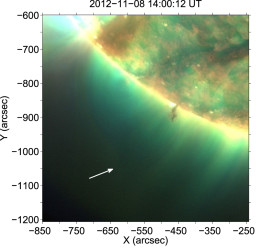On 7 November, 2012 at 08:00 UT, an enormous tornado of plasma rose from the surface of the Sun. It twisted around and around, climbing over the span of 10 hours to a height of 50 megameters — roughly four times the diameter of the Earth! Eventually, this monster tornado became unstable and erupted violently as a coronal mass ejection (CME).
Now, a team of researchers has analyzed this event in an effort to better understand the evolution of giant solar tornadoes like this one.
Oscillating Axis
In this study, led by Irakli Mghebrishvili and Teimuraz Zaqarashvili of Ilia State University (Georgia), images taken by the Solar Dynamics Observatory’s Atmospheric Imaging Assembly were used to track the tornado’s motion as it grew, along with a prominence, on the solar surface.
The team found that as the tornado evolved, there were several intervals during which it moved back and forth quasi-periodically. The authors think these oscillations were due to one of two effects when the tornado was at a steady height: either twisted threads of the tornado were rotating around each other, or a magnetic effect known as “kink waves” caused the tornado to sway back and forth.
Determining which effect was at work is an important subject of future research, because the structure and magnetic configuration of the tornado has implications for the next stage of this tornado’s evolution: eruption.
Eruption from Instability

SDO/AIA 3-channel composite image of the tornado an hour before it erupted in a CME. A coronal cavity has opened above the tornado; the top of the cavity is indicated by an arrow. [NASA/SDO/AIA; Mghebrishvili et al. 2015]
Based on these observations, the authors hypothesize that the eruption could be explained using the following model:
- A tornado and a related solar prominence forms.
- Magnetic field lines within it are gradually twisted by the tornado’s rotation, until the tornado becomes unstable to the kink instability (a magnetic instability).
- The tornado then destabilizes the entire prominence, which expands upwards and erupts into a CME through something known as the “magnetic breakout model.”
If solar tornadoes such as this one generally cause instabilities of prominences, they could be used to predict when a related CME is about to happen — providing important information for space weather predictions.
Citation
Irakli Mghebrishvili et al 2015 ApJ 810 89. doi:10.1088/0004-637X/810/2/89


1 Comment
Pingback: ჩვენი ნაშრომის საერთაშორისო აღიარება | ABASTUMANI ASTROPHYSICAL OBSERVATORY